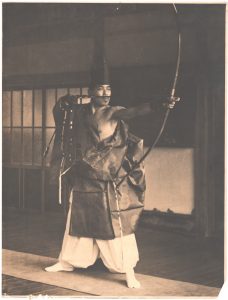
JR: You have chosen the archer’s shooting form depicted in this photograph. Tell me about the person who displays this form, about the archery school, and about archery itself and what your interest is in archery.
AI: This person is the founder of our school of Japanese archery, Shobo-Ryu, and he also contributed to the reconstruction of Japanese archery after WWⅡ. The founder, Yoshiyasu Yoshida, believed that Japanese archery is more than a mere sport and should be used for educational purposes. Therefore, even though the winner is the one who hits the target the most, players aim to gain the perfect shooting form rather than hit the target (they say if you shoot correctly, the arrow is supposed to hit the target though). Additionally, we have to abide by certain rules when we get ready for shooting to when we leave our position. There are other certain rules that we also have to adhere to when it comes to cleaning the training hall and watching players. By following these particular ways, players learn to become more disciplined and organized This makes Japanese archery different from normal archery, and this is why I am really into it.
JR: People often are drawn to particular instances of kinds of things because of their approximating some ideal or perfect form for that kind of thing. In the U.S., for example, when people search for their particular annual Christmas tree, they are very discriminating in their search for the tree with the “perfect Christmas tree form.” And, people can be similarly discriminating in selecting their produce at the market. But the form you’ve selected is ahuman form and one that the person must through discipline and rule following make great effort to realize only momentarily. Is there something about the form as achievement in this way that contributes to your judgement that it is beautiful?
AI: I think that my judgment is not influenced by the shooting form alone. But I also think that If a beginner at Japanese archery were to luckily attain the correct shooting form, for me, the form is beautiful. These two notions might sound contradicting, so I am going to explain why. What makes it beautiful for me is my experience while struggling to attain and maintain the perfect form while shooting, rather than the hard work and discipline that I see behind the master’s shooting form. No matter how much training the player went through, it won’t change the fact that the form is hard to achieve for most people as it requires a lot of training and discipline. In other words, my knowledge and experience while struggling to gain the perfect form is the element that enables me to identify the beauty behind the perfect form, no matter the effort the player put in to attain the form.
JR: Expand, for me, on the idea that “Archery should be used for educational purposes”; What exactly does this mean and what does one do to succeed at using Archery for such purpose?
AI: Through playing Japanese archery, including following particular rules, players become more disciplined and learn something important in their lives. For example, I played Japanese archery just for 2 years in high school. But I can list a lot of things that I’ve learned through the experience, such as the importance of facing my weak points to improve myself, respecting others and showing respect, and keeping a habit even if I get bored or do not feel like doing something I decided to do. Moreover, I believe that there are more things to learn if I continue to play. This is another teaching of Japanese archery that learning is never-ending.
JR: Do you think there something about the beauty of beautiful things (like the archer’s ideal form that a student aspires to accomplish) that contributes to their having educational efficacy? What, for example, do you think of views like Plato’s account of the role that beauty plays in the philosopher’s journey towards philosophical wisdom and communion with the forms (with reality)?
AI: Yes, I think the beauty of the ideal form contributes to the educational efficacy of Japanese Archery.
I mostly agree with Plato’s account. As Nehamas said that love is only a promise of happiness, I think our passion comes from something incomplete. I find my form incomplete and less beautiful compared to the ideal form, so I practice more and aim to be as educated and mature as our teachers. This could be an example of how beauty leads people to the truth. I also feel like this is chicken and the egg problem, though. We don’t know whether we find more beauty in something closer to the truth, or we call something truth when we find beauty in it.